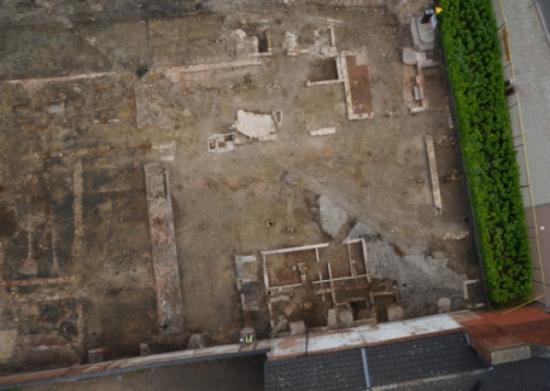Source - http://www.meltontimes.co.uk/community/nostalgia/centuries-old-artefacts-uncovered-at-car-park-site-1-5387672

An aerial photo showing the Burton Street frontage and the first phase (area one) of the archaeological works
Artefacts dating back several centuries have been uncovered during work to transform Melton’s Burton Street car park.
Archaeologists have discovered pottery from the Roman, medieval and post-medieval periods, medieval jetton trading tokens (a coin-like object) and a lead medieval bale seal - widely used in Europe during the 13th and 19th centuries as a means of identifying textiles, as well as parcels and bales of trade goods.
Experts from Peterborough-based Pre-Develop Archaeology have also uncovered partial remains of a building complex, in an area aligned with Burton Street, showing a possible Georgian furnace and Victorian floors, footings and services associated with an exterior cobbled surface which acted as the main route in off of Burton Street.
Derek Roberts, of Pre-Develop Archaeology, said: “These buildings were in existence up until the 70s at which point they were demolished. Systematic excavation down through these deposits has shown the existence of earlier features possibly associated with drainage for earlier properties or an earlier period in Burton Street’s history, possibly as far back as the 14th century.”
One of the sites uncovered is thought to be the former home of number 18 Burton Street, which had housed aristocracy in the past, and in later years became a garage.
The finds have been made during a £450,000 makeover of the BurtonStreet car park which began in June.
Work on the second half of the car park was due to start this week, with Pre-Develop Archaeology monitoring the stripping back of the old car park surface and again looking for evidence of buildings along Burton Street and Mucky Lane.
Mr Roberts said: “All finds and features exposed during urban archaeological excavations are vital to the understanding of the social and economic expansion of the earlier Saxon/medieval town.
“Area two (directly adjacent to Mucky Lane and running parallel with the present boundary between the car park and Play Close) revealed the remains of late medieval masonry associated with buildings pre-dating the current Georgian/Victorian layout of the car park boundary.
“An 1836 map of the area shows a large building of unknown use straddling the current boundary between Play Close and the car park. This is possibly related to the large stone walls seen during the excavation. In close proximity to these walls was a large piece of masonry interpreted as a late medieval bridge section. This had been destroyed by a later Georgian culvert which in turn had been modified during the Victorian period.
“An earlier 18th century map does show a stream running roughly east to west from the position of the old basin, now gone and replaced by the Burton Street rail bridge, down through Play Close to the river. These features could be associated with this stream which was later placed within a culvert, possibly around the time of the construction of the canal, destroyed in 1887.”
Mr Roberts added: “Richard Clark, Leicestershire County Council’s archaeological officer, has hinted at the possibility of an ancient traderoute from Burrough Hill Iron Age Hillfort.
“Current maps seem to show extant boundaries respecting a route from the fort, cutting through this area, up through the church yard to the market place in Melton. Such a well worn route would warrant the sort of expenditure associated with the sorts of masonry being found around the Play Close boundary.”